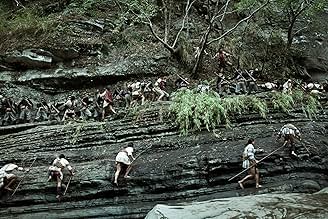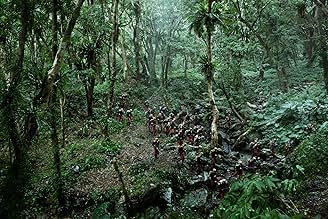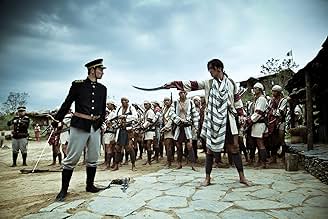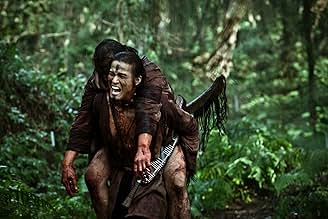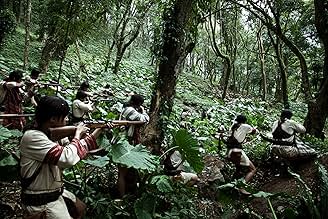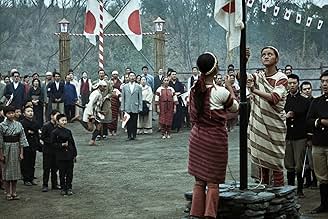Ajouter une intrigue dans votre langueAn indigenous clan-based people living in harmony with nature find their way of life threatened when violent interlopers from another culture arrive, intent on seizing their natural resource... Tout lireAn indigenous clan-based people living in harmony with nature find their way of life threatened when violent interlopers from another culture arrive, intent on seizing their natural resources and enslaving them.An indigenous clan-based people living in harmony with nature find their way of life threatened when violent interlopers from another culture arrive, intent on seizing their natural resources and enslaving them.
- Réalisation
- Scénario
- Casting principal
- Récompenses
- 15 victoires et 29 nominations au total
- Mona Rudao
- (as Lin Ching-tai)
- Baso Mona (Mona's Younger Son)
- (as Lee Shih-chia)
- Ichiro Hanaoka aka Dakis Nomin
- (as Bokeh Kosang)
Avis à la une
Before going to the theater, my first concern was whether it would become a stereotypical nationalism or humanism film, because The Wushe Incident had been represented so many times in our history class in Taiwan that it seemed to be too difficult to make this film without compromising on political correctness, but Te-Sheng Wei made it!
Sàidékè balái presented a mass of killing and death, not in a humanism or Han Chinese Nationalism way, but from the aspect of the Seediq. I have heard people arguing if it is necessary to have so much violence in this film, but I have to say that the value of peace or anti-war is the main stream nowadays but not so to the traditional Seediq that time. Therefore, I think the director is not a moral relativist, he just chose not to judge the past with today's value, and resisted the mainstream that drowned the voice of the minority.
It impressed me that there was little Chinese or Taiwanese through out this film. Instead, the film is composed of Seediq language and Japanese. We should cherish it that 80 years after the The Wushe Incident, we can finally see a film which represents historical event not based on the authority opinion but on people who didn't lead the history, i.e. the native.
Similar to previous comment, this movie reminds me of the situation in Tibet right now. How the "Han-ization" is happening when the culture and religion in Tibet is slowing disappearing. What would I do if I were one of the young men in the tribes in the movie?
And is this that much different to the change happening to our very own culture (both Eastern and Western) in the face of globalization and extreme consumerism? This is how much the film has provoked me into contemplating.
Also with all the head chopping and fighting scenes the director has successfully illustrates the values and beliefs of life of the tribes without a taint of violence. Yes it's bloody but not violent. Wonder how that is possible right? (This is refreshing in the midst of our media culture on big screens and on TV).
I would not use the word entertaining for this movie but nonetheless it is not as serious/"boring" as the topic and plot might sound. And 144 minutes just flew by without my notice and my 60+ years old parents were actually hoping to watch the second half right after the first.
Definitely a not-to-miss for this year!
Secondly, you have to know a little of history and tradition of Taiwan and roles of aboriginals to truly have a feeling for the movie. Just Wiki "Wushe Incident", and "Taiwanese Aboriginal" and that makes things much better as you watch.
Anyway back to the film, the selling point seems to be all the killing, the action, the big budget. However after watching it I've found out it's more about the value of "death" that the film tries to bring to us, and death weights in front of abstract values such as "tradition", "dignity", etc.
It's really an entertaining film for sure and throughout the 4.5 hrs time just flies, and you have to adjust yourself to have that desire to discover more about aboriginals believes and ways of living, much like watching documentary films mentality.
I can't stop comparing this "Civilization vs. Barbarian" plot to what is happening in middle east right now. In such sense history is repeating, and the film is definitely pointing out how pointless the loss of lives is (depends on which stand you are taking though).
Overall this is one of the best and most enjoyable films in recent years. The director is trying to lead us to think critically towards topics on death, values, tradition and how these would change when worlds collide.
This is easily one of the most emotionally charge epic war like movies to come out in a long time. With the amount of content that is included in this film, you can only imagine what else could have been cut out for this condensed US release. If you love Asian cinema, war films, or just great filmmaking, this is a must see film. Just be warned as mentioned before that there are some pretty heavy visuals.
http://www.examiner.com/movie-in-dallas/bobby-blakey
Le saviez-vous
- AnecdotesTaiwan's official submission to the Best Foreign Language Film category of the 84th Academy Awards 2012. To meet Academy regulations, the four-and-half-hour full version of the diptych was submitted as one entry.
- Citations
Mona Rudao: There are more Japanese people than the tree leaves in the forest, than the pebbles in Jhuoshuei River. But my determination to fight them is more adamant than Mt. Chilai! If your civilization wants us to cringe, I'll show you the pride of savages!
- ConnexionsFollowed by Sai de ke · ba lai: Cai hong qiao (2011)
Meilleurs choix
- How long is Warriors of the Rainbow: Seediq Bale I?Alimenté par Alexa
Détails
- Date de sortie
- Pays d’origine
- Sites officiels
- Langues
- Aussi connu sous le nom de
- Warriors of the Rainbow: Seediq Bale I
- Sociétés de production
- Voir plus de crédits d'entreprise sur IMDbPro
Box-office
- Budget
- 23 000 000 $US (estimé)
- Montant brut aux États-Unis et au Canada
- 136 166 $US
- Week-end de sortie aux États-Unis et au Canada
- 57 183 $US
- 29 avr. 2012
- Montant brut mondial
- 4 670 432 $US
- Durée
- 2h 24min(144 min)
- Couleur
- Rapport de forme
- 2.35 : 1


